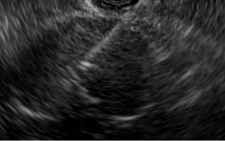EUS involves the use of a special endoscope with high-energy sound waves ("echoendoscope") to visualize internal organs (such as the inside of the digestive tract), permit biopsy of suspected lesions, and facilitate access to difficult fluid collection next to the digestive track. At the Center for Digestive Care, EUS is used in conjunction with the following procedures:
Endoscopic ultrasound (EUS)-assisted ERCP:
This approach combines two endoscopic procedures to perform interventional treatments, such as clearing of a blockage in a bile duct. First, an "echoendoscope" is inserted into the patient's mouth and throat, which uses high-energy sound waves to locate the obstruction and the opening of the bile duct. Then ERCP is used to place a metal or plastic stent to open the obstruction.
EUS-guided ERCP is also useful when there are either anatomic abnormalities that don't make it possible to use standard ERCP, such as intestinal pouches near the union of the pancreatic and common bile ducts, or when the intestines have been redirected after surgery (which often happens after weight loss surgery, peptic ulcer surgery, and certain other gastrointestinal operations). In addition, sometimes conventional ERCP is difficult or impossible to perform when a tumor is completely obstructing the bile duct or its entrance.
EUS with fine-needle aspiration (FNA):
A type of biopsy, FNA is used to remove tissue from masses or cysts for examination. With ultrasound guidance, the physician places a very fine, hollow needle into the mass or cyst and removes a small sample of tissue or fluid. This sample is analyzed to determine the nature of the mass or cyst, and whether surgery is necessary to remove it. In the case of some cysts, EUS is used to inject the cyst to cause them to shrink.

EUS-guided pseudocyst drainage
In other cases, such as to help diagnose pancreatic cancer, EUS is used to place stents (slender tubes) into the pancreatic duct or from the duodenum of the small intestine into the bile duct for drainage. In the case of individuals at high risk for cancer, EUS can help screen them for abnormalities and determine whether additional tests are needed. If a patient is diagnosed with pancreatic cancer, EUS can help determine whether the cancer is operable or not. If the cancer is not operable, EUS spares patients from unnecessary surgery.
EUS-guided celiac plexus block or neurolysis: The celiac plexus is a group of nerves that supply organs in the abdomen. A celiac plexus block is a form of local anesthesia used to treat severe or chronic abdominal pain, such as that caused by pancreatitis. EUS is used to locate the location where the anesthetic needs to be applied. A needle is inserted through the endoscope and anesthetic is applied this way, rather than through the outside of the abdomen (as is the case with conventional celiac plexus block). Celiac plexus neurolysis is the same procedure, but utilizes injection of pure alcohol to kill the celiac plexus nerve. It is reserved for patients with pancreatic and biliary cancers and provides dramatic relief of pain.



